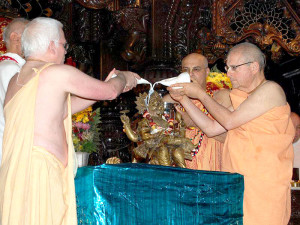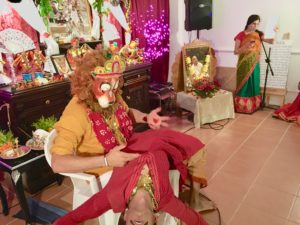By Madhava Smullen
This Spring’s ISKCON New Vrindaban (INV) and ECO-Vrindaban (ECO-V) Board Meetings saw another inspiring round of Department Head Presentations on March 25th, as everyone gears up for a busy 2017 summer season and New Vrindaban’s 50th anniversary in 2018.

Varsana Swami opened the session with an invocation reminding an audience of GBC, board members, and residents of Srila Prabhupada’s vision for New Vrindaban. He focused on the community’s status as a holy pilgrimage site, and uplifted all by quoting Prabhupada’s statement from a 1975 letter, “I am always praying to Krishna that the New Vrindaban attempt will be more and more successful and ideal for your country. That is my only prayer.”

INV President Jaya Krsna Das then reiterated goals to follow Prabhupada’s instructions for the community, care for and cooperate with each other, and make devotees throughout North America proud to be associated with New Vrindaban.

Sri Tulasi Manjari, ECO-V’s new Board Chair since January 2017, then kicked off the ECO-V department head presentations with an overview of the organization’s mission, board, and staff. She also introduced guests including Fil Paonessa, who may be joining the ECO-V team full time, and Board Advisor candidates Olivia Snider, Makara Pitts and Venkata Chalpati.

ECO-V’s department heads presented first, beginning with Ananda-Vidya Das and Lalita Gopi Dasi of Milking and Cow Care. They are milking seven cows, getting 20 gallons of milk per day, and stocking the Deity kitchen with butter and ghee. Cow care has been improved with new sliding doors, a birthing stall gate, and a new tractor for bringing hay; while new wall paneling, insulation, and heating are keeping the cowherds happy in the winter. Coming up, three new calves are due, and the team will start making sour cream, and will plant flowers around the barn.

In the Deity Flower Garden, Vidya Dasi and Suchandra Dasi plan to provide nearly all the flowers for the Deities’ day-to-day needs during the growing season. They’ll also give devotees seeds and encourage them to grow flowers and vegetables for the Deities at home. Other 2017 goals include using a new greenhouse to extend the flower season, involving guests and devotees in picking flowers and making garlands, and creating a welcome center at the Teaching Garden.

In Garden and Ox Power, Nitaicandra Das reported that four oxen are already following basic commands and will learn to pull a cart and transport logs by the end of the year. Devotees plan to harvest five to eight thousand pounds of potatoes at the Valley Field this year; and grow corn, beans, squash and grains for the cows in the Community Garden; as well as a large variety of vegetables at Nandagram. Meanwhile greens will be grown into the winter this year in a new partially underground greenhouse.
Concluding the ECO-V section of the morning, Nitaicandra also announced that ECO-V will teach courses on cow care and gardening at Festival of Inspiration from May 12th to 14th this year; and will co-host the next ISKCON North American Farm Conference at New Vrindaban from October 13th through 15th.
During a break between the presentations, board member Chaitanya Mangala Das conferred appreciation plaques upon departing board members Bhima Walker (ECO-V) and Keval Patel (INV), who each served for three years. Bhima thanked the board for the opportunity to serve and said “I really enjoyed my time,” while Keval also expressed his gratitude and said it had been “an eye-opening experience” to see the dedication and hard work at New Vrindaban. Both helped usher in a new era in the community, with many next generation devotees following their examples and volunteering to get involved in meaningful ways.
Starting the ISKCON New Vrindaban presentations, Prabhupada’s Palace manager Vraja Kishor Das outlined plans to increase visitorship by 15%; launch a capital campaign for fixing the Palace roof; renovate the tour guide’s office; increase book distribution; plant perennials around the Palace and assure excellent tours.

In Prabhupada’s Palace Restoration, Gopisa Das described how this year, Prabhupada’s kitchen will be renovated with brand new cabinets, appliances and even electrical wiring, so that offerings can be cooked onsite. Restoration of the road side of the Palace wall is almost done and will be completed with intricate window grills, while the inside is set to be completed later in the year. And the main stairs leading up to the Palace will get new fabricated handrails.

In Devotee Care, Sukhavaha Dasi is focusing on preventative health care by organizing healthy prasadam meals for temple devotees and having visiting doctors do regular check-ups. She’s also arranging for devotees with R1 visas to get free Health Rite Care. For mental health, she’s working to create a culture of clear communication and safe confidentiality. Last but not least, a Child Protection Team is making sure the temple is a safe place.
Sukhavaha also presented the Deity Department. There, each pujari has been scheduled to dress the same Deity every day, to create a relationship between the two and enhance the quality of worship. A back-up system has been created to prevent emergencies, and there’s a clear system of communication where pujaris feel they can express their needs.
Vrindavan Das reported on Communications, highlighting the 2017 goal to publish nearly 30 articles about New Vrindaban throughout the year on Dandavats and ISKCON News, and six to eight in outside regional newspapers and magazines. Social media updates will be increased to at least twice a week, and e-newsletter Brijabasi Spirit will be published quarterly.
Vrindavan also heads up Marketing. In that department devotees plan to promote New Vrindaban as a tourist destination by distributing up to 18,000 new brochures, attending regional tourism and trade shows, producing a new promotional video, and collaborating with the local Convention Visitor’s Bureau.

Next Vasudeva Das reported on the Palace Lodge. The rooms are getting more repairs; the cabins’ thirty-year-old furniture is being replaced with high class Hampton Inn furniture; and the Welcome Center is being upgraded with new décor and guest seating. Other 2017 plans include getting uniforms and name tags for staff; installing security cameras, and promoting to more target groups. Vasudeva also hopes to renovate the last two rooms in the temple guest wing.
The Finances department now has an all-new team for the new season, with Bhaktin Angie, who has previous experience in the field, and former lodge manager Gaura Bhakta Das. The two will be trained up and hope to implement several improvements to fulfill Srila Prabhupada’s instruction that every penny should be tracked and meticulously accounted for.

In Festivals, new coordinator Pradeep Sethi reported that he had put together a new festival committee. As well as all the regular Vaishnava holidays, he said they would inaugurate the new Yoga Shala on April 15th and 16th; organize a second annual japa retreat with Gita Nagari’s Ekavira Das and Vraja Lila Dasi from April 21st to 24th; and hold the redesigned Festival of Inspiration in May. Finally from September 29th to October 1st, the second Prabhupada Festival will reconnect with previous residents ahead of next year’s NV50 festival.
Meanwhile Brihat Kirtan Das is overseeing both the Restaurant and Devotee Kitchen, allowing them to share cooks, groceries and preparations. This will increase efficiency and reduce waste. In addition the devotee kitchen aims to set a weekly menu that keeps devotees’ health in mind. And the restaurant will be open seven days a week during the season, and will expand its menu to cater more to the health-conscious yoga crowd.

In Maintenance and Construction, Bhagavan Das reported new flooring in the temple hallways, and wood-look tile in the entranceways. There’s a new maintenance building where construction staff can meet and have a convenient one-stop storage space for all their construction tools and materials. The Yoga Shala, a beautiful new yoga venue on the lakeside has been completed and inaugurated. Coming up, new siding will be put on the Lodge and Wellness Center, the swan boat house and lake chattras will be renovated, and the original Vrindaban farmhouse wll be restored in time for NV50 next year.

In Congregational Development, Gaurnatraj Das presented plans to expand the Kartik outreach program, visiting many donors and introducing Damodarastakam to them. He also laid out plans to continue Facebook Live lectures, offer a Gita Crash course, and reach out to East and West Coat ISKCON temples to bring more pilgrims to New Vrindaban. Finally, he said his department would reach out to Western guests through the new Yoga Shala and would hold daily and extended retreats, and special programs for youth, children and yoga teachers.

Finally, Gopal’s Garden Homeschool Co-Op, headed by Ruci Dasi, has seen its students increase substantially in number. To make space, the preschool room has been renovated and expanded and will become home to the elementary students; while their old classroom will now be home to the Preschool, run by Sundari Dasi and Mercy Mack.
Devotees attending the presentations felt enthused to hear about the work already done so far this year, and about what’s planned for the rest of 2017. With many departments now maintaining the impressive progress they’ve made in the past few years, and exciting new construction projects being completed, things are coming together ahead of New Vrindaban’s 50th Anniversary celebrations in 2018.




















 By Nrisimhadeva das
By Nrisimhadeva das


 Srila Prabhupada liked trusts. He set up at least 3 trusts
Srila Prabhupada liked trusts. He set up at least 3 trusts By the TOVP Staff
By the TOVP Staff
 By Braja Vilas das
By Braja Vilas das








 Jayananda didn't like being praised over others, he felt others to be doing more service than he, and he was always a team player, giving all credit to Srila Prabhupada and all the devotees, never thinking any one devotee to be less significant than himself. Whether they were a temple president, or a new bhakta washing the pots, Jayananda glorified all other devotees over himself. This is the mood that Jayananda wants us to continue, to always honor all devotees equally.
Jayananda didn't like being praised over others, he felt others to be doing more service than he, and he was always a team player, giving all credit to Srila Prabhupada and all the devotees, never thinking any one devotee to be less significant than himself. Whether they were a temple president, or a new bhakta washing the pots, Jayananda glorified all other devotees over himself. This is the mood that Jayananda wants us to continue, to always honor all devotees equally. 
 By Michael Scherer
By Michael Scherer 